
The Bottom Line
Introduction, Specifications, and Pricing
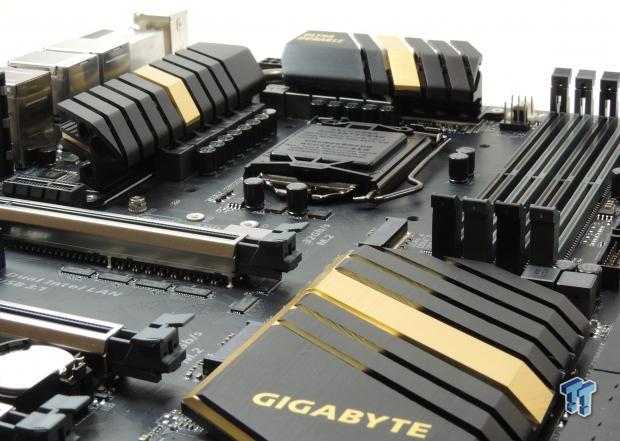
Many have said that Intel Z170 motherboards are boring; they say that there is not much variation in features and capabilities. The truth is that even though most boards have the same features in terms of connectivity, they are very different, and manufacturers have made sure of that. In the past, the Intel PCH (platform controller hub) could be complemented by many third-party controllers to provide extra connectivity, but Z170 already packs more punch than all Z97 motherboards without additional controllers. This means that product differentiation must come from things other than connectivity. To evaluate motherboards these days, you must not only look at connectivity and performance, but also at aesthetics, component quality, and unique features.
Like most manufacturers, GIGABYTE has revamped their entire lineup, but they kept their traditional numbering scheme. GIGABYTE's main lineup has traditionally been their Ultra Durable series that offers quality and features at an affordable price tag. The UD5 series has traditionally been an interesting one, and the Z170X-UD5 is no exception. GIGABYTE recently sent over the Z170X-UD5 for us to test and evaluate, and today I will share my experience with this product.
Specifications

The Z170X-UD5 is a well-rounded motherboard. It uses all of Intel's basic features from the PCH and even adds more. GIGABYTE added two extra SATA ports on top of Intel's six, used seven USB 3.0 connections directly from the PCH, and added a second Intel NIC. The board is PCI-E heavy as well, and while it only supports up to 2-way SLI and 3-way CrossFireX (like the majority of Z170 motherboards), the last full sized 16x slot is a 4x slot that shares its bandwidth with the M2 slot.
There are two M.2 slots, the one that doesn't share its bandwidth with the PCI-E 16x (4x slot) does share with four of the SATA ports. In the end, GIGABYTE offers a wide assortment of possible connectivity options. The specifications of this board are quite good, especially considering the board has all the latest features, including Intel USB 3.1.
Pricing
The GIGABYTE Z170X-UD5 is currently priced at $189.99 on Newegg and Amazon at the time of writing, both with free shipping. That is in the middle of most Z170 motherboards, but at around the $200 mark, I start expecting things like high quality components and OC features, and the Z170X-UD5 has both.
Packaging and the Z170X-UD5
Packaging and the Board


There is nothing too special about the box other than a promo for "Heros of the Storm" as GIGABYTE is an official sponsor of BlizzCon. The board is packaged inside an antistatic bag and well protected from the elements.

Accessories include 4x SATA6G cables, IO shield, 2-Way SLI bridge, G-Connector (for front panel headers), IO panel port protectors for video outputs, driver DVD, case badge, door hanger, and manuals.
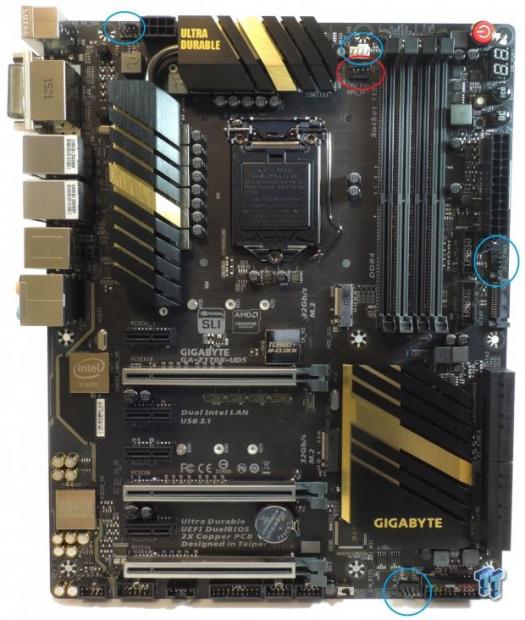

The GIGABYTE Z170X-UD5 has five fan headers. The single one circled in red is the PWM header and the four circled in blue are 4-pin voltage mode headers. All headers will work with both PWM and voltage mode fans. The motherboard itself has a gold/black color scheme, but instead of a heavy emphasis on gold, like on the previous Z97X-UD5H, the emphasis is now on black. This makes it much easier to mix and match case accessories, and most people prefer black to gold. The shade of gold here isn't very dark; it is more like the champagne color of the iPhone depending on the angle of observation. I think GIGABYTE did a nice job with the heat sink design, and the heat sinks are big and should cool the components well. The motherboard is full sized ATX. The back of the motherboard is pretty bare of components, which is a good thing. There are only a few LEDs on the underside to illuminate the PCB divide for the audio subsection.

The IO Panel features 3x USB 3.0 ports, 1x USB 3.1 Type-A, 1x USB 3.1 Type-C, 2x USB 2.0 ports, two Intel NICs, DVI, HDMI, DisplayPort, PS/2 KB/Mouse, 7.1 audio outputs with TOSLINK.


The PCI-E layout is pretty much standard. The first and second full sized PCI-E 16x slots work at 16x/0x with one card or 8x/8x with two cards. The last 16x slot is electrically 4x and wired to the PCH instead of the CPU. The M.2 slot closest to the last PCI-E 16x slot shares bandwidth with it, so you can use one or the other, not both. All the PCI-E 1x slots are hardwired to the PCH at 1x. Both M.2 slots can run at 4x PCI-E 3.0, but you will sacrifice some SATA and the last PCI-E 16x slot if you use both at the same time. For Z170, M.2 uses many of the same ports as SATA allowing manufacturers to provide both, but allowing the use of one or the other to expand options. You might also notice that the PCI-E 16x slots have a solid metal guard over them. This shield/guard over the slots helps protect the physical integrity of the slot from bending or pulling of the video card. GIGABYTE claims that their metal PCI-E shield design is stronger than others which aren't one solid piece.


There are a total of eight SATA6Gb/s ports. There are also three SATA Express connectors and each SATA Express connector is shared with the two SATA ports adjacent to it. Two SATA ports are hooked up to a third-party ASMedia controller, the rest that are SATA Express/SATA6Gb/s are connected directly to the PCH. In the image on the right, there is a connector for SATA power input to the motherboard for extra PCI-E power and two USB 3.0 internal headers. All seven of the USB 3.0 ports (four from headers and three on the IO panel) are directly connected to the PCH.


GIGABYTE has their AMP-UP audio on the Z170X-UD5. The gold Nichicon capacitors match the gold heat sinks quite well. GIGABYTE also added some styling to the PCB for the isolated audio subsection. GIGABYTE included overclocking features on the Z170X-UD5, including a POST Code display, voltage read points, power button, reset button (white), auto OC button, auto ECO (power savings) button, and a clear CMOS button (black).


There is a single BIOS mode switch, which will disable the dual BIOS functionality of the motherboard for easier overclocking recovery and troubleshooting. There is no dual BIOS selector switch, and I am not sure why GIGABYTE removed this feature. GIGABYTE has soldered metal shields over many of the critical ICs, one of them being the extra clock generator for better BLCK overclocking.

The heat sinks on the Z170X-UD5 are all screwed into the motherboard and the contact between the heat sink and the ICs is very good.
Z170X-UD5 Circuit Analysis
Circuit Analysis
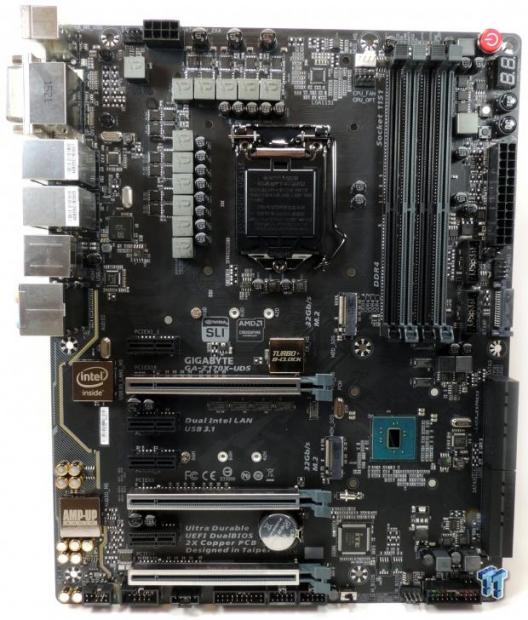
In my opinion, motherboards look best when they don't have any heat sinks on them, but I know a lot of you like your heat sinks so I will take them off and do the circuit inspection so you don't have to!

If you count the phases, this VRM is an 8+3 phase VRM (VCC + VCCGT). The VCCIO and VCCSA do not come from switching converters, but rather linear regulators, since they are low power rails. There are four major input rails to the CPU for Z170; VCC (VCore), VCCGT (Graphics core), VCCSA (System Agent), and VCCIO (CPU IO). Counting the phases from the top left to the bottom right, the first eight inductors (chokes) are for the CPU VCore and the other three are for the VCCGT (graphics). GIGABYTE is using a 4+3 phase PWM and the phases for the CPU VCore are doubled by doubling the components for each of the four phases, the VCCGT phases are not doubled.


The Intersil ISL95856 is a hybrid digital PWM which has a total of 4+3 phase outputs with three integrated drivers. The CPU VCC (VCore) uses all of the four phases, two drivers are integrated and two ISL6625A labeled (5AZ) are used for the third and fourth drivers. Each driver outputs to two sets of MOSFETs and two inductors. The VCCGT (integrated graphics) uses all of the three phases from the PWM and two ISL6625As are used as the second and third drivers.
The MOSFETs are from Vishay Siliconix, the SiRA12 and SiRA18 TrenchFETs (brand name) are the low-side and high-side PowerPAK MOSFETs for the CPU VCore and CPU Graphics. GIGABYTE is using its 560uF custom made Chemicon 10K Japanese capacitors as well as their power ferrite core chokes. These are the same MOSFETs that GIGABYTE used on their Z97 motherboards. The image on the right shows the linear power regulators for the VCCSA and VCCIO, the capacitor on the left outputs VCCSA and the capacitor on the right outputs the VCCIO.


The memory VRM is a single phase powered by a Richtek RT8120D PWM and the Vishay SiRA12 are used, two for the low-side and one for the high-side. This should be more than enough for most DDR4 overclocking. Intel is using two Intel NICs, the i211AT is the discrete NIC under the EMI shield not shown, and then there is the i219v which is the PHY for the integrated MAC in the PCH. This is the ideal solution for enthusiasts who prefer Intel over Killer or Realtek networking hardware.


GIGABYTE's AMP-UP audio consists of a Realtek ALC1150 under the EMI shield and a single OP1652 amplifier for the front HD audio headers for headphones. There are also 11 Nichicon gold electrolytic audio capacitors for the audio output. There is also a PCB divide, which is illuminated by 14 yellow LEDs, on the backside of the motherboard.
Z170X-UD5 Circuit Analysis Continued
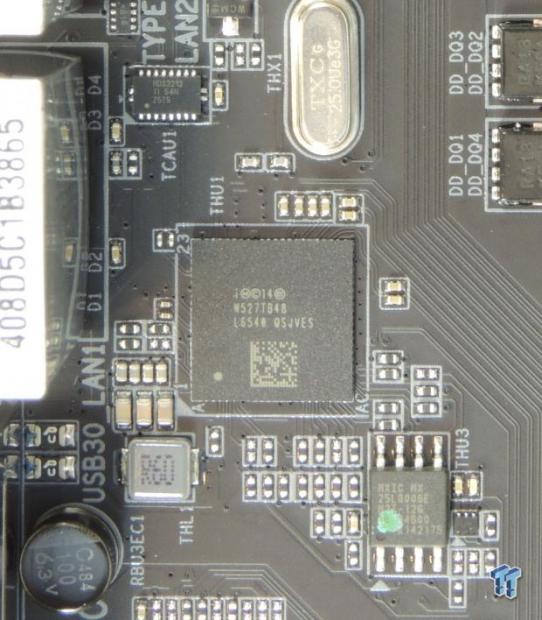
Intel is using the Intel "Alpine Ridge" Thunderbolt 3.0/USB 3.1 controller. While this chip supports Thunderbolt 3.0 as well as USB 3.1, it requires more hardware and two more PCI-E lanes than are being allocated here to support it. That is why GIGABYTE only is advertising USB 3.1 support and not Thunderbolt 3.0. Most boards with this controller are only using it for USB 3.1, but a few boards have a much more intricate and integrated solution which uses more resources and PCI-E lanes. While this isn't the Thunderbolt 3.0 implementation of this IC, there is still extra hardware required for proper Type-C connector implementation. GIGABYTE has added the proper Type-C switch from Texas Instruments, the HDS3212.


A single ASMedia ASM1061 provides two SATA 6Gb/s ports from a single PCI-E 3.0 lane. There are six ASMedia ASM1480s PCI-E 3.0 quick switches in the image on the right. Four of them are used to switch 8x PCI-E 3.0 from the first PCI-E 16x slot to the second PCI-E 16x slot for multiple video cards. The other two quick switches are for switching 4x of bandwidth from the lower M.2 slot to the last PCI-E 16x port (4x electrical).


There are three more ASM1480s used to switch SATA bandwidth to the upper M.2 slot if it is in use. You can use both the M.2 slot and most of the SATA ports. For the right allocation of SATA bandwidth, refer to the manual for the bandwidth allocation table. The VRM in the image with the RT8120 is for the DDR VPP 2.5v rail. In the image on the right, we have both 128Mbit BIOS ROMs and the SuperIO, an iTE IT8628E.

An NXP level shifter is used to convert the digital video output from the CPU into HDMI/DVI for the connectors on the back panel IO.
BIOS and Software
BIOS
At the beginning, GIGABYTE's UEFI was only the classic based advanced mode that I have taken screenshots of below. After I updated to the most recent UEFI, the orange and easy mode BIOSes came back, which can be a bit confusing if you don't read this review. You should only use the advanced mode (gray) as it has everything; the other BIOS modes are just redundant.
Overall, the BIOS was stable; I didn't run into to any problems that would give me a headache. Some boards I have used have problems detecting drives or allowing easy drive selection for booting, but GIGABYTE makes it pretty easy. All the overclocking settings you would ever want are present, plus some more hidden settings. Even though this is a public UEFI, Intel has so many behind the scenes settings for DRAM and CPU overclocking that GIGABYTE's engineers didn't hide them, so you can tinker with them if you want. This includes IMC timings and extra internal VR settings. Don't be confused, the CPU doesn't have the FIVR, but some settings are internal to the CPU's internal power management.

The only thing missing from the UEFI is a graphical interface for fan control. You are able to set linear slopes for the PWM control method on each individual header, but you can't pick points at which the fan increases in speed. This isn't a huge downside, and there are built in profiles which provide a cooling curve rather than a straight line, but hopefully in the future GIGABYTE will implement a GUI like other vendors have.




























Software

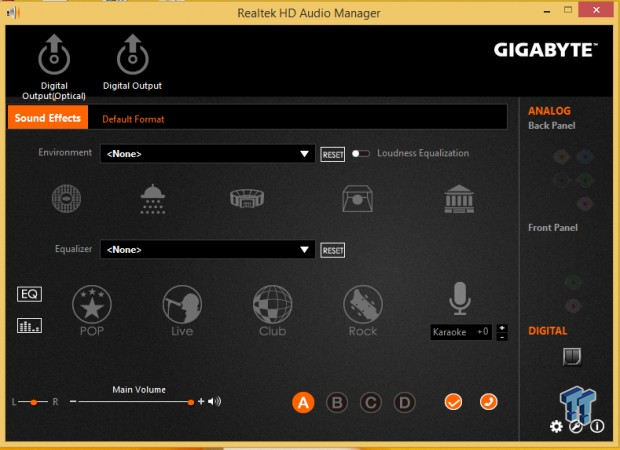
Since GIGABYTE is using dual Intel NICs on the motherboard, they are employing the cFOS software suite for users to control the LAN and outgoing and incoming data. GIGABYTE has also customized the Realtek audio software suite to better suite their orange and black BIOS color scheme.

With Z170, GIGABYTE has provided tons of software, and they have given the entire suite a makeover. I actually really like the look of white and blue color theme compared to the theme from last generation. In the image above, we have @BIOS, Ambient LED, AutoGreen, USB Blocker, EasyTune, HomeCloud, and App Center.


GIGABYTE has provided in-Windows fan control through their System Information Viewer program which provides that GUI based variable fan control that is lacking from the UEFI. The software can even calibrate the fans. Other than SIV, there is SmartKeyboard, SmartTimelock, EasyRAID, Platform Power Management, and FastBoot. The image on the right shows GIGABYTE's custom Gaming G1 CPU-Z skin as well as GIGABYTE's GTL, which is for tweaking OC settings in Windows.
Test System Setup
Test Setup
A big thanks to Corsair for sponsoring the case, fans, SSD, USB drive, and PSU! A big thanks to BitFenix for sponsoring the white Alchemy power and SATA cable extensions! A big thanks to Kingston for sponsoring the HyperX Predator M.2 Drive and USB 3.1 USB drive for drivers and benchmarks! A big thanks to Seek for sponsoring the Thermal Camera - you can find my review of the camera here.
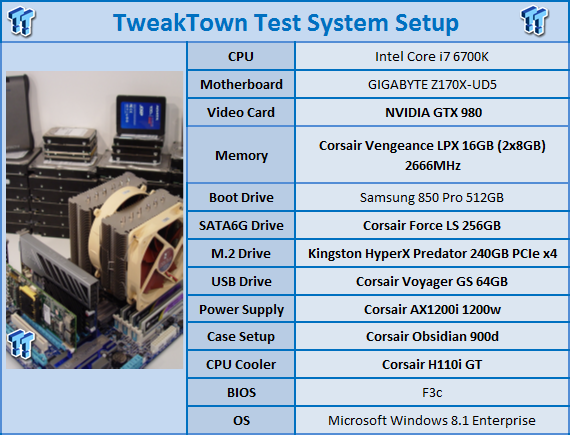

This is the new test bench, and it is designed to test every aspect of the motherboard and IO. I have designed it so that the motherboard sits in a case and is cooled by fans always on at a constant rate to keep the conditions similar for all tests. I have cut out part of the case behind the motherboard so I can get thermal images of the back of the PCB where the VRM heat spreads. System and CPU power measurements are now digitally logged.
I am also using a Netgear Nighthawk X4 AC2350 for our network (including wireless AC) tests. The latest M.2, SSD, and USB technologies are also being utilized to test the maximum potential of the motherboards that are being tested.
Overclocking
Overclocking Results
CPU Overclocking
CPUID recently released their latest CPU-Z version which brings some major changes to the much loved software. One of these changes has made it harder to get a validation at lower stability levels, so it becomes much more troublesome to validate 5.2GHz at 1.5v with every board. While CPU-Z has changed, many motherboards (not this one) don't have LLC. I have to set a higher voltage to compare all these boards at the same voltage. I have decided to reduce the CPU VCore to 1.4v applied (I will measure real VCore at the output capacitors), and see how high I can validate. On most boards its 5.0-5.1GHz. I have also decided to add real voltage levels compared to what is set for all motherboards, if they don't have voltage read points I will mark where I got the readings from.

The Z170X-UD5 is doing 5.1GHz.


AIDA64 is a useful program to grab settings, run benchmarks, and do stability testing. However, its stability test isn't the most stringent, especially if you don't increase the allotted memory size, so I have decided to test stability another way. I am using HandBrake to transcode a 2GB video, and it is very telling since it pulls all cores to maximum frequency and load. Handbrake is good for a quick stability check, plus I get a log of the encoding speed and the number of errors. It is very easy for the queue not to finish all the way and just error out, and 1-3 hours of AIDA is about equal to this HandBrake test, so I am replacing it.


While there are three settings for LLC (Auto, Standard, and High), "Auto" and "Standard" produce the same results. The "High" setting is actually quite good, and it provided a tiny bump in voltage during loads. I measured at the output capacitors, since it's easy for me to reach the back of the motherboard when it is powered on (I cut out the back of the case), but there are voltage read points which will differ from capacitor readings by only a few millivolts.
Memory Overclocking
I have decided to also change some things for the memory section. Clocking standard XMP has become easier, and ever since launch, memory performance and overclocking has gotten better too. I have decided to expand the overclocking tests to the following:



Test 1: 4x8GB (32GB) Corsair Vengeance LPX 2666MHz C16

I added a second Vengeance LPX kit to my previous memory test for 32GB of memory. This test is to see if the board can apply XMP meant for two DIMMs to four DIMMs of the same make and model, and the Z170X-UD5 booted and applied the settings without issue.
Test 2: 4x4GB (16GB) Corsair Dominator Platinum 3200MHz C16

Here I am using a kit meant for X99 on Z170, this is a fast kit at the speed more people will run below for 24/7 operation. The board handled this kit without issue.
Test 3:2x4GB (8GB) G.Skill Ripjaws V 3600MHz C17

This 3600MHz kit doesn't work on many boards, most overclocking motherboards operate it fine, but the board has to be tuned for it. The Z170X-UD5 isn't an extreme overclocking board and it wasn't able to easily boot this with XMP (I am told it will be fine with a future BIOS update). The settings would take, but it wasn't very stable, so I ended up setting 3466MHz instead, which ended up giving me enough stability.
CPU, Memory, and System Benchmarks
CINEBENCH 11.5
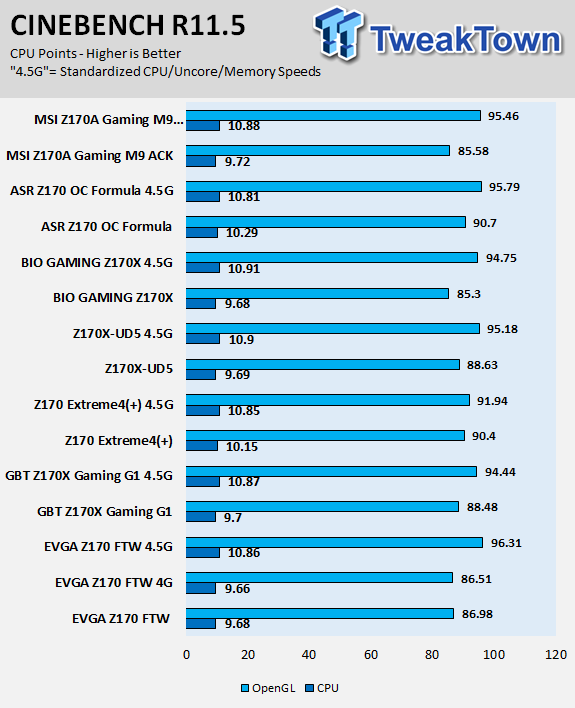
wPrime
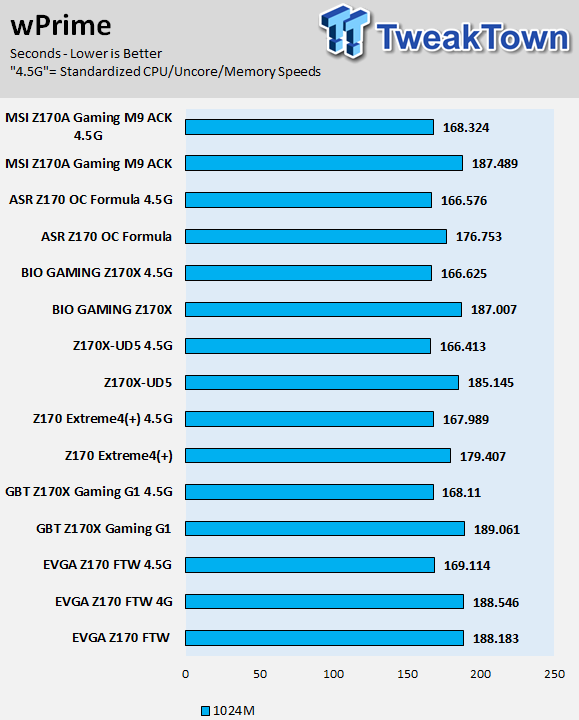
AIDA64 AES and HASH

AIDA64 FPU

AIDA64 Memory

PCMark8 Home Test

3DMark: Cloud Gate

3DMark: Fire Strike

3DMark: IceStorm
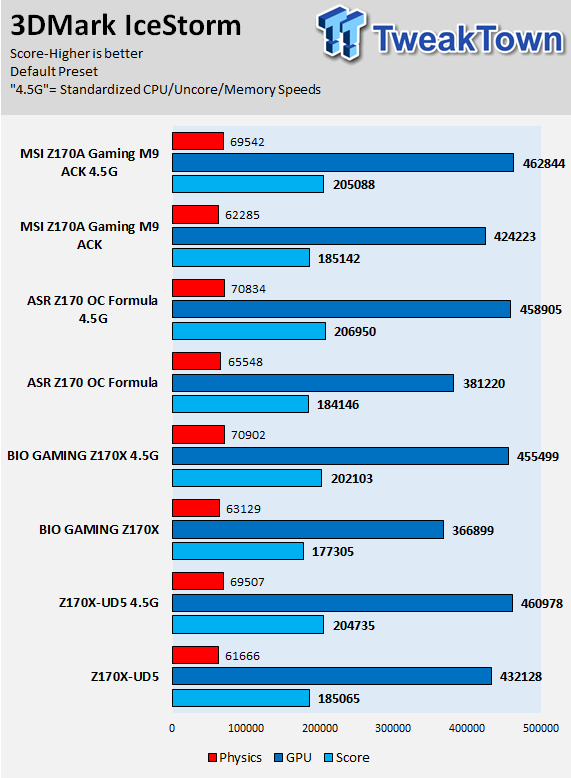
Resident Evil 6

GIGABYTE's Z170X-UD5 holds its own against other motherboards. Sometimes motherboard manufacturers will tune boards towards better scores in one area which results in a decrease in performance in another. Overall, the Z170X-UD5 does top the charts in a few benchmarks. All around it has good performance and doesn't seem to be tuned for any single purpose (CPU, memory, or GPU).
Some motherboard reviewers put a lot of weight into motherboard CPU, memory, and GPU benchmarks, but for me CPU, memory, and GPU benchmarks on motherboards should be more about finding anomalies and I do that at standard settings (4.5G in graphs). I believe that the system IO benchmarks on the next page are more important and they do tend to differ more from one model to the next.
System IO Benchmarks
CrystalDiskMark SATA6G:

CrystalDiskMark M.2:

CrystalDiskMark USB 3.0:
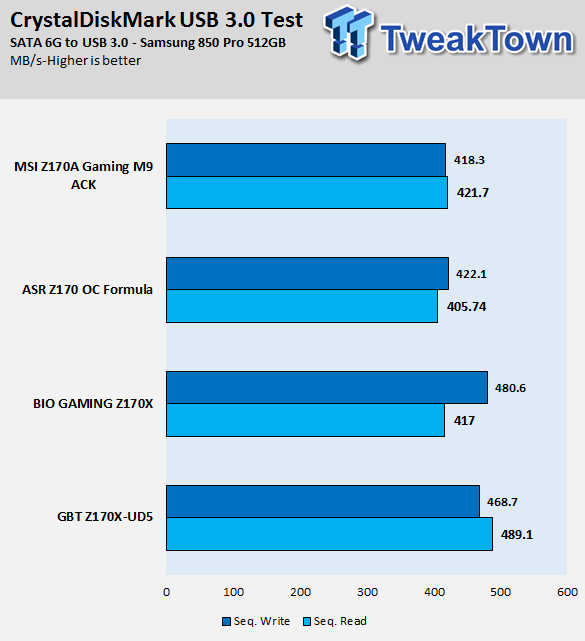
ixChariot Network Throughput:
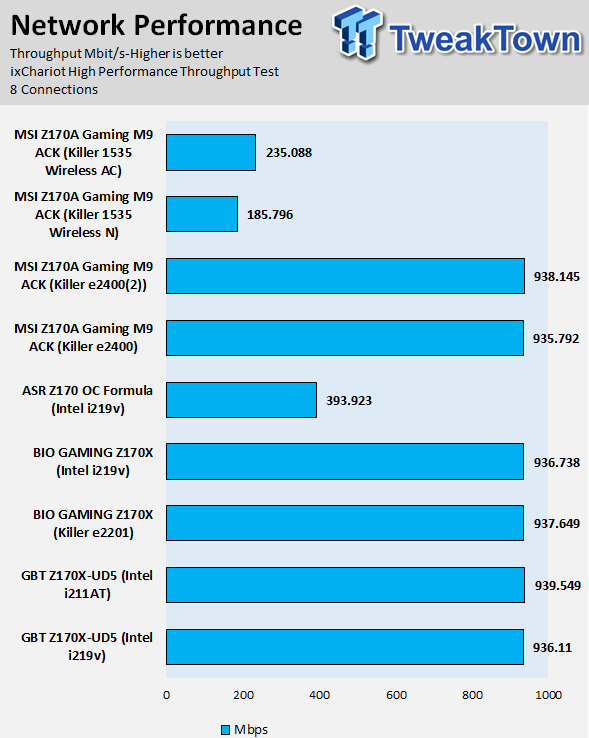
I changed the hardware configuration for some benchmarks and changed how the networking benchmark is done. I changed out the SATA6G SSD to a Samsung 850 Pro, I changed the way USB 3.0 testing is done (now it is done with an external SSD), and I heavily increased the number of connections for network testing so that all NICs won't hit the 940 Mbps maximum.
Overall, the two Intel NICs on the Z170X-UD5 perform very well; SATA and M.2 performance is very good as is USB 3.0 performance. The Z170X-UD5 is designed so that each USB 3.0 connection is directly routed to the PCH; there are no hubs or extra controllers.
Audio RMAA 5.5:
I disable all audio features, set the correct bitrates, and then test the audio with a loopback test.

Sound Judgment by Ear: Very good audio capabilities, the audio is clear and the highs and lows are pretty evident, the AMP is only for the front panel audio output, so the output isn't as loud as on other boards I have tested. There are 5 ratings for audio: 1. Problems, 2. Okay, 3. Acceptable, 4. Very good, 5. Excellent
Thermal Imaging and Power Consumption
System power usage is measured at the AC/DC PSU (the Corsair AX1200i) which I have connected to another system to measure the test system, and as a backup I have a wall meter to verify. The CPU power is measured through the 8-pin connector, which is hooked up to a hall effect IC, which measures current and puts out a voltage in proportion to the current. That voltage is logged by a National Instruments ADC, which logs the DC voltage level that I then convert into current.
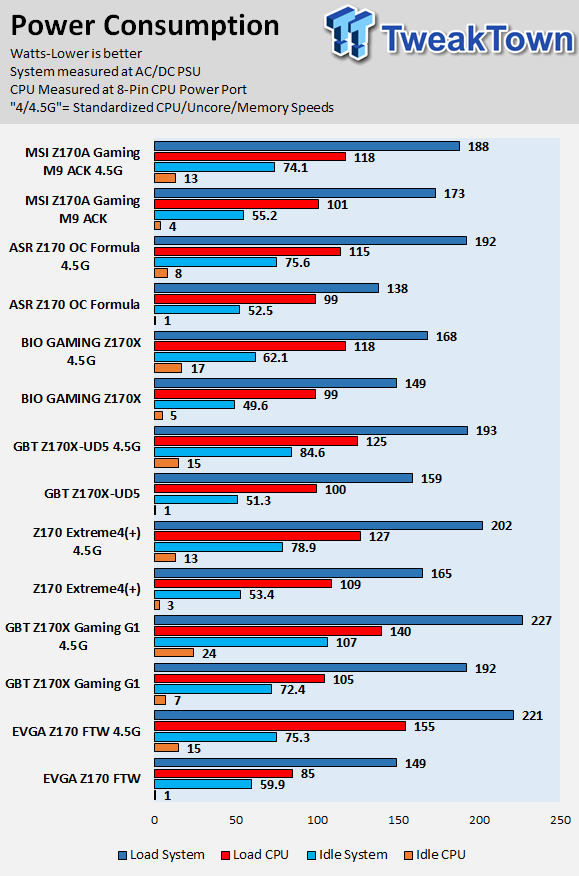
Note on Thermal Images: In the temperature section, we use our Seek thermal imaging camera to capture the surface temperatures of major components on the board. I look at the VRM and then all other things that light up the screen. If there is something to worry about, then I will state it, otherwise I will just show the hotter running parts of the board for fun. Unless some component is over 80-90C, then there really isn't anything to worry about.
All systems will act differently, so I will look for commonalities, such as how far from the VRM the heat spreads through the PCB and the difference in temperature between the front side and backside of the PCB. Keep in mind, the majority of the heat from the VRM goes into the PCB as it is a giant soldered on copper heat sink. A larger difference in temperature between the back and front of the PCB points towards a more effective heat sink.
Thermal Testing at Stock Speeds:
The image on the left is always at idle and the image on the right is at load. During ALL TESTS, fans above the VRM that cool the CPU cooler's (Corsair H110i GT) radiator are turned on to high (12v).


Full frontal.


Up-close of the front of the VRM.


Up-close of the back of the VRM.
Thermal Testing at 4.5GHz Overclocked Speeds:


Full frontal.


Up-close of the front of the VRM.


Up-close of the back of the VRM.
The VRM on the Z170X-UD5 isn't the best I have seen on the Intel Z170 platform, but it's also not close to the worst and handled every overclock I threw at it. It runs very cool at stock, cooler than other hot areas of the board like the USB 3.1 controller and the M.2 drive. When the system is overclocked, the VRM does its job to power the CPU well; there aren't any issues and it does seem that the heat sink is doing its job as the backside temperatures didn't exceed those on the front. There is a 4C increase on the back from idle to load when the system is overclocked and this is a minimal increase. For some reason, the load temperatures got cut out of the picture, but at 4.5GHz the temperature on the hottest inductor is 41C at idle it is 31C.
Anything under 60C is great, 60-80C is acceptable, and anything above 80C is a bit worrisome (if at stock).
What's Hot, What's Not & Final Thoughts
This is where you can fast forward to the final section of the review, and get a quick recap and points on the GIGABYTE Z170X-UD5.
What's Hot
Lots of Connectivity Options for the Price: GIGABYTE has done a decent job of offering up a lot of ports and slots above what the standard Intel configuration provides. GIGABYTE not only added a second NIC, but also two extra SATA ports. Most people prefer connections directly from the Intel PCH as performance and compatibility are usually much better compared to third-party controllers. GIGABYTE doesn't use any hubs on its motherboard, but it does use a decent amount of switches to allow users to choose whether they want to use an M.2 based devices or one that plugs directly into a PCI-E slot or SATA/SATA Express port.
This might seem a bit tricky, as many users figure that all ports should work at all times, but GIGABYTE has highlighted in the manual and specifications on their site what connections will work with different configurations. For example, many people are looking into NVMe storage, and NVMe comes in different form factors. The Z170X-UD5 lets you decide which you want to use. The last PCI-E slot and bottom most M.2 connector share the same 4x PCI-E 3.0, and you can chose which NVMe form factor you want to use. At this price range, you can't expect more PCI-E connectivity than is allotted by the PCH, but with the switches, at least you can pick the form factor to use. The high number of SATA Express also means you will be able to hook up an aftermarket USB 3.1 front panel bay device if you so choose.
Dual Intel NICs: It isn't very common to see dual Intel NICs on motherboards anymore, but the Z170X-UD5 provides just that. Many people prefer Intel NICs over others because of their low latency and reputation. Nevertheless, the performance of both Intel NICs is quite strong, and in this price range many boards are using Killer's gaming solutions, but the Z170X-UD5 is using more of a workstation implementation.
All Direct Intel USB 3.0 and Intel USB 3.1: All USB 3.0 comes directly from the Intel PCH and doesn't go through any hubs. GIGABYTE is using seven USB 3.0 connections from the PCH, one above the normal amount. All USB 3.1 comes from Intel's "Alpine Ridge" USB 3.1/Thunderbolt 3.0 controller. While the Intel "Alpine Ridge" controller on this board is only configured for USB 3.1, it still should offer the performance levels we have come to expect from Intel products.
OC Features: GIGABYTE made sure to include a POST code display and even voltage read points, along with the standard power, reset, and clear CMOS buttons we have come to expect as part of the overclocking package. At this price point, it is very nice to see these features. On top of the standard OC features, there also is an OC button for an automatic overclock and an ECO button for power savings. There is also a dual BIOS disable switch.
Aesthetics: GIGABYTE has shifted from all gold heat sinks to black heat sinks with hints of gold, and I think they are moving in the right direction. People look for motherboards that will match the rest of their system, and to be honest, there aren't many gold accessories, but little hints of gold in this case can be kind of appealing. The LED lighting and Nichicon gold capacitors match the gold hints in the heat sinks, and I am not sure if this was done purposely, but the matching is quite nice.
What's Not
BIOS could have GUI fan control: While you do have a nice GUI and much better fan control in Windows, the fan control the UEFI hasn't changed for years. While GIGABYTE has expanded fan control to individual control over every header on the motherboard, the "custom" option in the UEFI is limited compared to some competitors.
No BIOS selector switch: While GIGABYTE provides a Dual BIOS disable switch and two BIOS ROMs, they do not provide the dual BIOS selector switch. I applaud the OC features, but I would trade the ECO button for a dual BIOS selector switch or even jumpers.
Final Thoughts
At $189.99 at the time of writing, the Z170X-UD5's price is very competitive. Dual NICs, good allotment of storage options, Intel USB 3.1, and OC features put it among the better values in the $200 price point. GIGABYTE's attention to quality is also present, and component selection is good. While the VRM on the Z170X-UD5 doesn't come close to the VRM on the Z170X-GAMING G1, it also comes in at less than half the price. Overclocking was pretty easy to accomplish, and memory overclocking should be good enough for the majority of users. The board performed well under the thermal camera as well.

I had two caveats with the board; there is no BIOS selector switch and they could have provided more BIOS based fan control, but other than those two things, I couldn't really nitpick much more. Performance all around was decent; the board is well rounded and should do well in almost all situations. The Z170X-UD5 performs in all types of benchmarks, especially when it comes to IO testing such as USB.

| Performance (including Overclocking) | 95% |
| Quality including Design and Build | 90% |
| General Features | 91% |
| Bundle and Packaging | 88% |
| Value for Money | 90% |
| Overall | 91% |
The Bottom Line: Overall the GIGABYTE Z170X-UD5 provides a very good feature set and great performance at a competitive price. If you are in the market for a well-rounded motherboard, then you should give this board a look.
PRICING: You can find products similar to this one for sale below.
 United
States: Find other tech and computer products like this
over at Amazon.com
United
States: Find other tech and computer products like this
over at Amazon.com
 United
Kingdom: Find other tech and computer products like this
over at Amazon.co.uk
United
Kingdom: Find other tech and computer products like this
over at Amazon.co.uk
 Australia:
Find other tech and computer products like this over at Amazon.com.au
Australia:
Find other tech and computer products like this over at Amazon.com.au
 Canada:
Find other tech and computer products like this over at Amazon.ca
Canada:
Find other tech and computer products like this over at Amazon.ca
 Deutschland:
Finde andere Technik- und Computerprodukte wie dieses auf Amazon.de
Deutschland:
Finde andere Technik- und Computerprodukte wie dieses auf Amazon.de
Similar Content
Related Tags
